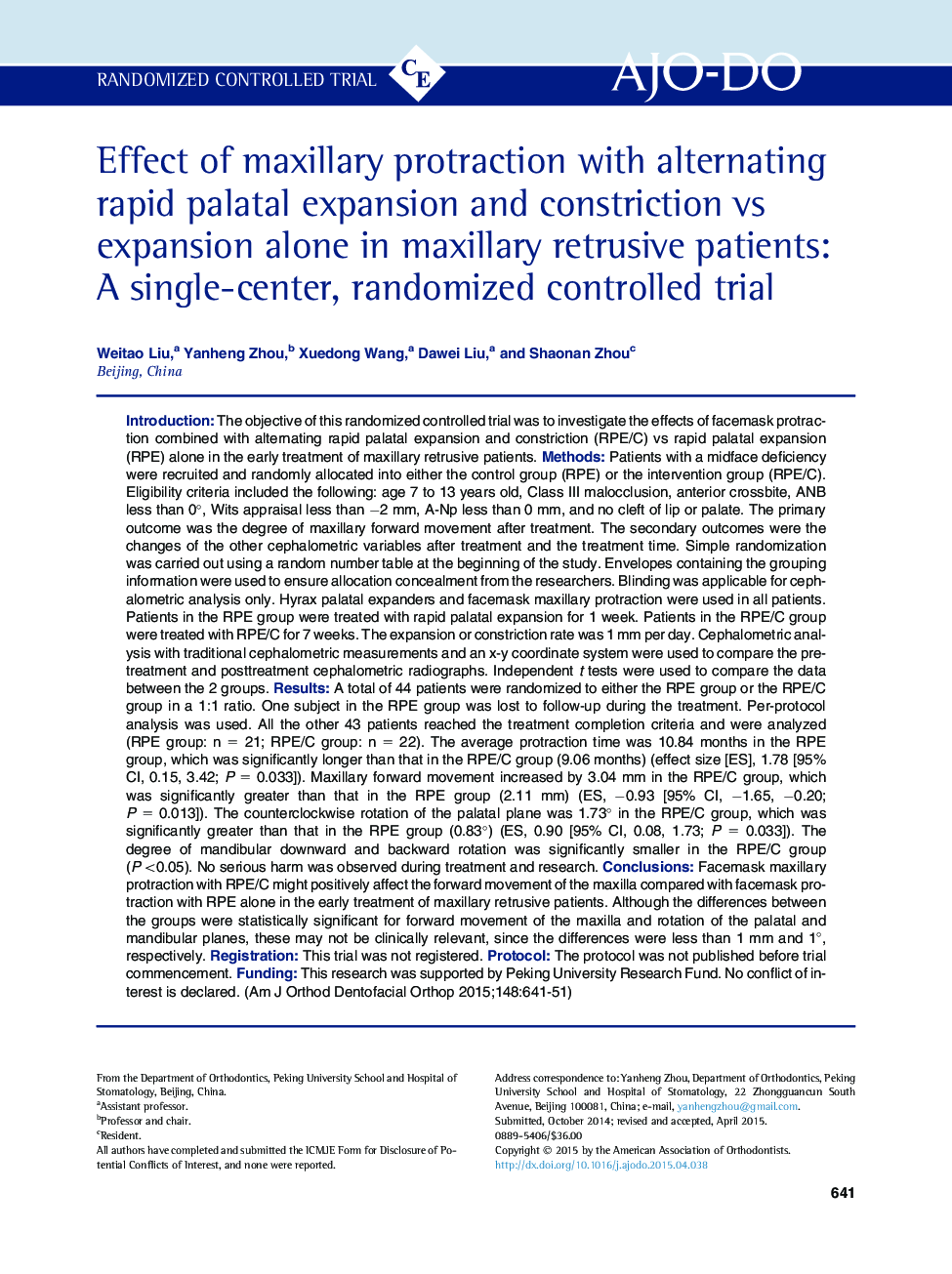| Article ID | Journal | Published Year | Pages | File Type |
|---|---|---|---|---|
| 3115870 | American Journal of Orthodontics and Dentofacial Orthopedics | 2015 | 11 Pages |
•Hyrax alternating rapid palatal expansion and constriction (RPE/C) and facemask protraction resulted in greater maxillary forward movement.•Greater palatal plane counterclockwise rotation was observed in the RPE/C group.•Less mandible downward and backward rotation was observed in the RPE/C group.
IntroductionThe objective of this randomized controlled trial was to investigate the effects of facemask protraction combined with alternating rapid palatal expansion and constriction (RPE/C) vs rapid palatal expansion (RPE) alone in the early treatment of maxillary retrusive patients.MethodsPatients with a midface deficiency were recruited and randomly allocated into either the control group (RPE) or the intervention group (RPE/C). Eligibility criteria included the following: age 7 to 13 years old, Class III malocclusion, anterior crossbite, ANB less than 0°, Wits appraisal less than −2 mm, A-Np less than 0 mm, and no cleft of lip or palate. The primary outcome was the degree of maxillary forward movement after treatment. The secondary outcomes were the changes of the other cephalometric variables after treatment and the treatment time. Simple randomization was carried out using a random number table at the beginning of the study. Envelopes containing the grouping information were used to ensure allocation concealment from the researchers. Blinding was applicable for cephalometric analysis only. Hyrax palatal expanders and facemask maxillary protraction were used in all patients. Patients in the RPE group were treated with rapid palatal expansion for 1 week. Patients in the RPE/C group were treated with RPE/C for 7 weeks. The expansion or constriction rate was 1 mm per day. Cephalometric analysis with traditional cephalometric measurements and an x-y coordinate system were used to compare the pretreatment and posttreatment cephalometric radiographs. Independent t tests were used to compare the data between the 2 groups.ResultsA total of 44 patients were randomized to either the RPE group or the RPE/C group in a 1:1 ratio. One subject in the RPE group was lost to follow-up during the treatment. Per-protocol analysis was used. All the other 43 patients reached the treatment completion criteria and were analyzed (RPE group: n = 21; RPE/C group: n = 22). The average protraction time was 10.84 months in the RPE group, which was significantly longer than that in the RPE/C group (9.06 months) (effect size [ES], 1.78 [95% CI, 0.15, 3.42; P = 0.033]). Maxillary forward movement increased by 3.04 mm in the RPE/C group, which was significantly greater than that in the RPE group (2.11 mm) (ES, −0.93 [95% CI, −1.65, −0.20; P = 0.013]). The counterclockwise rotation of the palatal plane was 1.73° in the RPE/C group, which was significantly greater than that in the RPE group (0.83°) (ES, 0.90 [95% CI, 0.08, 1.73; P = 0.033]). The degree of mandibular downward and backward rotation was significantly smaller in the RPE/C group (P <0.05). No serious harm was observed during treatment and research.ConclusionsFacemask maxillary protraction with RPE/C might positively affect the forward movement of the maxilla compared with facemask protraction with RPE alone in the early treatment of maxillary retrusive patients. Although the differences between the groups were statistically significant for forward movement of the maxilla and rotation of the palatal and mandibular planes, these may not be clinically relevant, since the differences were less than 1 mm and 1°, respectively.RegistrationThis trial was not registered.ProtocolThe protocol was not published before trial commencement.FundingThis research was supported by Peking University Research Fund. No conflict of interest is declared.
